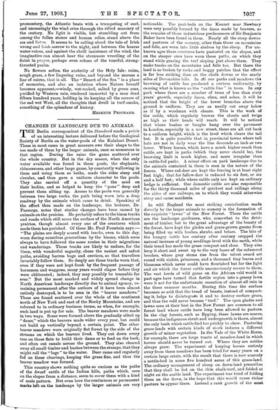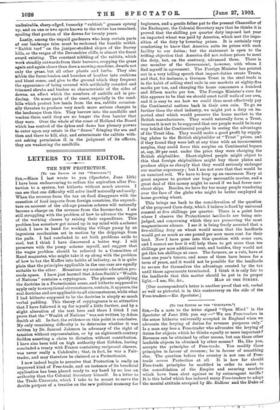CHANGES IN LANDSCAPE DUE TO ANIMALS.
THE Berlin correspondent of the Standard sends a précis of an interesting lecture delivered before the Geological Society of Berlin on the water-pools of the Kalahari Desert. These in most cases in great measure owe their shape to the use made of them by the larger animals, once so numerous in that region. During the rains the game scattered over the whole country. But in the dry season, when the only water available was found in these pools, the elephants, rhinoceroses, and other large game, by constantly wallowing in them and using them as baths, made the sides steep and circular, and thus gave a uniform character to the pools. They also carried off a quantity of the mud on their bodies, and so helped to keep the " pans " deep and prevent them silting up. Access to the pools was generally between two large rocks, the path being worn into a deep roadway by the animals which came to drink. Speaking of the effect thus made on the landscape, the lecturer, Dr. Passarge, notes that similar changes have been caused by animals on the prairies. He probably refers to the bison tracks and roads which still score the surface of the North American prairies, though almost every one of the creatures which made them has perished. Of these Mr. Paul Fountain says :— "The plains are deeply scored with tracks, even to this day, worn during countless generations by the bisons, which seem always to have followed the same routes in their migrations and wanderings. These tracks are likely to endure, for the bison, with wonderful sagacity, chose the easiest and safest paths, avoiding barren bogs and crevices, so that travellers invariably follow them. So deeply are these tracks worn that, even if they were not kept fresh by the frequent passage of horsemen and waggons, many years would elapse before they were obliterated; indeed, they may possibly be traceable for ever." But the most marked and widely spread change in North American landscape directly due to animal agency, re- maining permanent after the authors of it have been almost entirely destroyed, is to be seen in the " beaver meadows." These are found scattered over the whole of the continent north of New York and east of the Rocky Mountains, and are referred to in ordinary business terms, as when, for example, such land is put up for sale. The beaver meadows were made in two ways. Some were formed above the gradually silted up " dame," which the beavers made wider every year, but could not build up vertically beyond a certain point. The other beaver meadows were originally flat forest by the side of the streams on which the beavers lived. They cut down every tree on these flats to build their dams or to feed on the bark, and often cut canals across the ground. They also cleared away all small timber and bushes between the stumps, that they might roll the "logs " to the water. Deer came and regularly fed on these clearings, keeping the grass fine, and thus the beaver meadow was formed.
This country shows nothing quite so curious as the paths of the dwarf cattle of the Indian hills, paths which, seen on the slopes from a distance, seem to cover them with a kind of scale pattern. But even here the continuous or permanent marks left on the landscape by the larger animals are very noticeable. The peat-beds on the Kennet near Newbury were very possibly formed by the dams made by beavers, as the remains of those industrious predecessors of Sir Benjamin Baker have been found in them. Nearly all the steep downs and pastures of the country, other than those on mountains and fells, are worn into little shelves by the sheep. For un- known ages these creatures have pastured on the slopes, and on the steeper ones have worn these paths, on which they stand while grazing the turf sloping just above them. They make tracks on the mountains and fells too. But there the land is so broken by rocks and boggy patches that the effect is far less striking than on the chalk downs or the marly sides of Devonshire bills. In all our parks and meadows the browsing of cattle has produced a curious uniformity, by causing what is known as the " cattle line " in trees. In any park where there are a number of trees of less than sixty years' growth, especially limes, elms, and ashes, it will be noticed that the height of the lower branches above the ground is uniform. They are as neatly cut away below as if by a woodman with shears. This is the work of the cattle, which regularly browse the shoots and twigs as high as their heads will reach. It will be noticed that where bushes or boughs hang over the pavement in London, especially in a new street, these are all cut back to a uniform height, which is the level which clears the tall hat. It is quite possible that in provincial towns where tall hats are not in daily wear the line descends an inch or two lower. Where horses, which have a much higher reach than cattle, are kept in parks (which they never should be), the browsing limit is much higher, and more irregular than in cattle-fed parks. A minor effect on park landscape due to the animals contained in them is seen in the nature of the fences. Where red-deer are kept the fencing is at least eight feet high; that for fallow-deer is reduced to six feet, or six and a half feet; while where cattle only are kept an ordinary hedge is sufficient. Our domestic cattle are also responsible for the thirty thousand miles of quickset and railings along the sides of our railways, on to which they would otherwise stray and cause accidents.
In wild England the most striking contribution made directly by the larger animals to scenery is the formation of the exquisite "lawns" of the New Forest. There the cattle are the landscape gardeners, who, somewhat to the detri- ment of timber, but to the great advantage of the beauty of the forest, have kept the glades and grass-grown greens from being filled up with bushes, shrubs, and briars. The bite of the hungry cattle has century after century cropped the natural increase of young seedlings level with the earth, while their tread has made the grass compact and close. They also keep it short and sweet up to the very bases of the columned beeches, whose grey stems rise from the velvet sward set round with violets, primroses, and a thousand tiny leaves and blossoms which never could have flourished but for the light and air which the forest cattle unconsciously secure to them. The vast herds of wild game on the African veld would in past ages have turned that fertile region into a grassy lawn were it not for the unfortunate cessation of almost all rain in the three summer months. During this time the surface becomes so and that the tread of beasts, instead of compact- ing it, helps to disintegrate it and to destroy surface grass, and thus the veld never became "turf." The open glades and lawns seen at their best in the New Forest are common to all forest land where cattle have long been allowed to pasture. In the clay forests, such as Epping, these lawns are scarce, because the indigenous shrub and undergrowth is thorn, almost the only bush which cattle find too prickly to chew. Pasturing grass-lands with certain kinds of stock induces a different growth of minor vegetation. In the Vale of the White Horse, for example, there are large tracts of meadow-land in which horses should never be turned out. Where they are nettles always grow. The experiment of keeping horses entirely away from these meadows has been tried for many years on a certain large estate, with the result that there is now scarcely a nettle-bed in some five hundred acres of this grass-land. The ordinary management of sheep on down-land prescribes that they shall be fed on the thin chalk-turf, and folded at night on the arable land. The experiment was tried of folding them on the down, in the hope that this would cause richer pasture to appear there. Instead a rank growth of the most
undesirable, sharp-edged, tussocky " rubbish " grasses sprang up, and on one or two spots known to the writer has remained, spoiling that portion of the downs for twenty years.
Lastly, among the unpaid gardeners who keep certain parts of our landscape trim must be reckoned the humble rabbit. "Rabbit turf " on the juniper-studded slopes of the Surrey hills, or the verges of the Devonshire cliffs, is almost the finest sward existing. The constant nibbling of the rabbits, which work steadily outwards from their burrows, cropping the grass again and again closer than does a mowing-machine, dwarfs not only the grass, but all other plants and herbs. They also nibble the furze-bushes and bunches of heather into cushions and blunt cones, and give to the ground which they frequent the appearance of being covered with artificially rounded and trimmed shrubs and bushes so characteristic of the sides of downs, an effect which the numbers of anthills aid in pro- ducing. On some parts of the coast, especially in the sand- hills which protect low lands from the sea, rabbits occasion- ally threaten to produce very much more serious changes in the landscape than this. They burrow into the sandhills and weaken them until they are no longer the firm barrier that they were. Over the whole of the coast of Holland the Board which has control of the dykes and dams has plenary powers to enter upon any estate in the " dunes" fringing the sea and then and there to kill, slay, and exterminate the rabbits with- out asking permission if, in the judgment of its officers, they are weakening the sandhills.























































 Previous page
Previous page